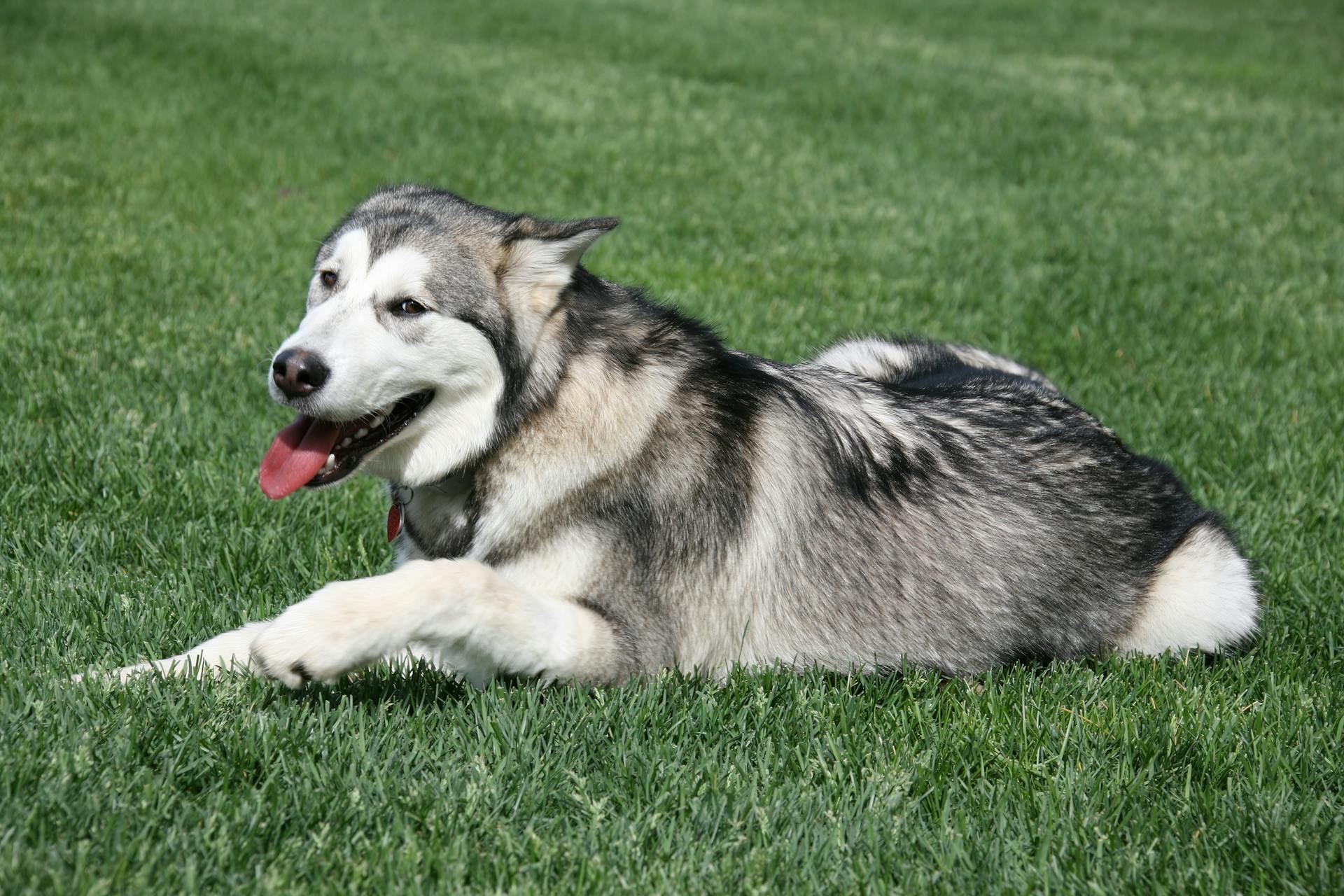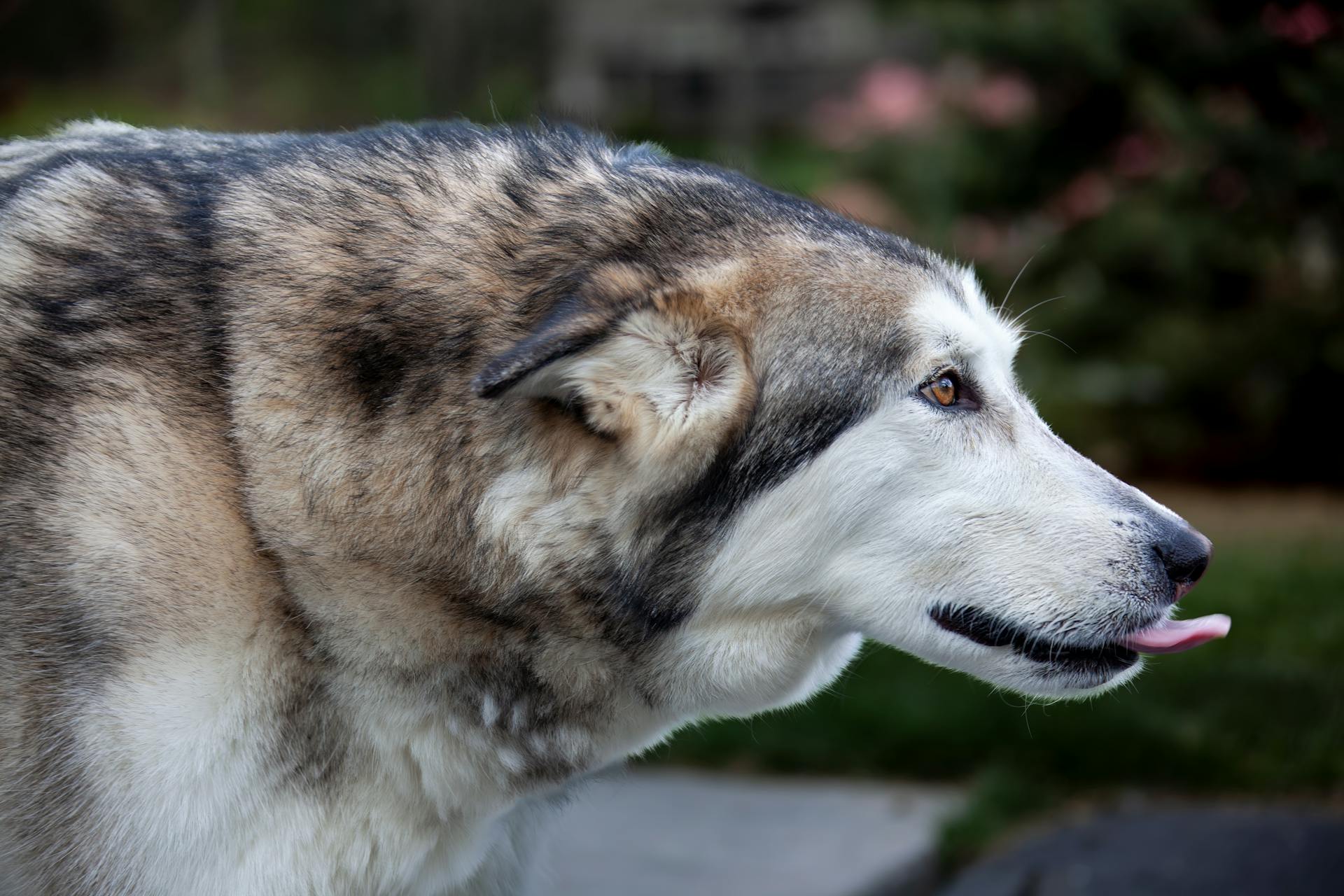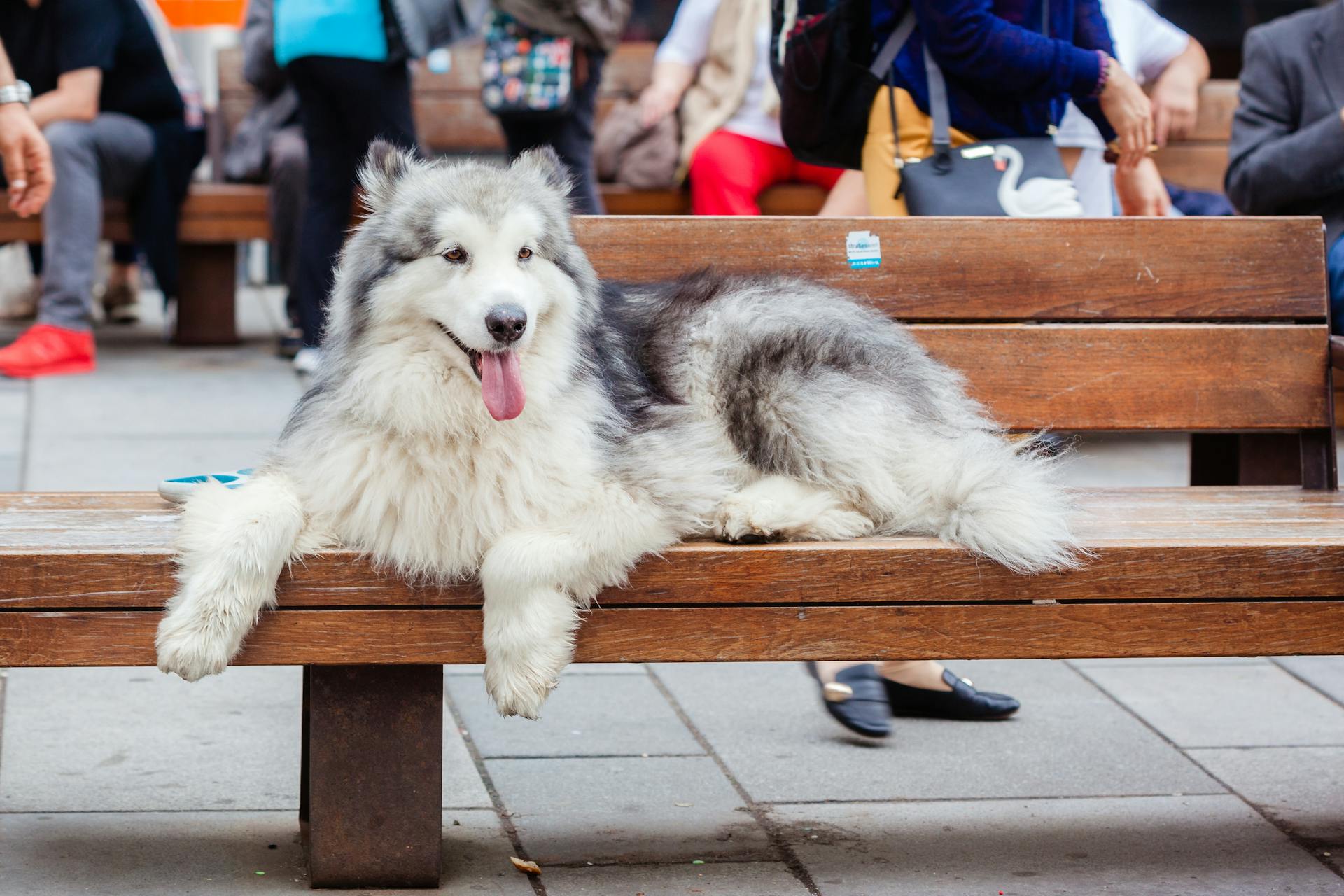
Alaskan Malamutes are a unique breed that require special attention and care. They are known for their strong prey drive and high energy levels, making them a great fit for experienced dog owners who can provide them with adequate exercise and mental stimulation.
In their natural habitat, Alaskan Malamutes were bred to be working dogs, pulling sleds and hunting in the Arctic wilderness. This history has left them with a strong instinct to chase and follow commands.
To manage their behavior, it's essential to establish clear boundaries and rules from an early age. Consistency and positive reinforcement are key to teaching an Alaskan Malamute what is expected of them.
Alaskan Malamutes are highly intelligent dogs that thrive on mental and physical stimulation. They require regular exercise, such as daily runs or hikes, to keep them happy and healthy.
Related reading: Malamute Shedding
Understanding the Breed
The Alaskan Malamute breed is a robust companion for those who delight in its heritage and spirit. With roots deeply planted in the snowy landscapes of Alaska, these dogs have evolved as both hardworking sled dogs and affectionate members of the family.
Their temperament mirrors their imposing size, striking a balance between gentle playfulness and assertive energy. This unique combination makes them a captivating study in canine uniqueness.
Alaskan Malamutes can happily live with children as long as they are well socialised with them from an early age. Care should be taken, as with any large dog.
All dogs and children need to be taught to get on with and respect each other, and be safe together.
Size and Appearance
The Alaskan Malamute size is truly impressive, typically standing around 23-25 inches in stature.
These dogs carry a weight that bodes well with their robust build, reaching anywhere from 75 to 100 pounds—and sometimes surpassing that.
Their plush, dense coat of varying colors requires regular grooming to maintain its splendor.
Adaptability
The Alaskan Malamute's adaptability is a topic worth exploring. Their thick double coat, ideally suited to harsh Arctic winters, can cause distress in hot weather.
They're not suited for warm climates, so if you live in a region with high temperatures, you'll need to take special care to ensure their comfort and well-being. This means providing plenty of shade, water, and rest breaks to prevent heat exhaustion.
In contrast to their Husky cousins, Malamutes are more sensitive to heat and may not adjust as well to diverse climates. They're best suited for cooler, more temperate regions.
If you're considering bringing a Malamute into your family, it's essential to research their needs and ensure you can provide a suitable environment. With the right care and attention, they'll thrive and become loyal companions.
Here are some key points to consider when thinking about the Alaskan Malamute's adaptability:
Creating a Comfortable Space
Creating a Comfortable Space is crucial for your Alaskan Malamute's well-being. Designing the ideal home space involves more than just aesthetics, it's about creating a living environment that resonates with their breed-specific needs for comfort, security, and engagement.
Alaskan Malamutes thrive on companionship and pack interaction, so their indoor environment should reflect a space of inclusion and comfort. They require ample room to stretch out and relax.
A sturdy crate is essential for providing a secure space for your Malamute to retreat to when left alone. This crate should be sturdy and comfortable.
The ambient temperature is a crucial aspect to consider, as Malamutes can overheat due to their thick coats. Keep your home cool through air conditioning or fans during warmer periods.
By implementing these practical steps, you equip your Malamute with a loving and conducive habitat, letting them remain active, mentally stimulated, and an integral part of your family dynamic.
Expand your knowledge: Are Malamutes Good Guard Dogs
Essential Training and Socialization
Training and socialization are crucial for Alaskan Malamutes to become well-adjusted canine citizens. They're naturally sociable, but need guidance to develop respect and obedience.
Effective training begins with puppyhood and continues throughout their lives, shaping their behavior and interactions with humans and other animals. Consistency is key – regular training sessions help establish a strong foundation for obedience.
To mitigate their natural predispositions, socialization with a variety of people, environments, and other animals is essential. Exposing your Malamute to positive experiences during puppyhood lays a foundation that diminishes aggressive behavior and bolsters their friendliness.
Here are some essential training strategies for Alaskan Malamutes:
- Begin training early to set firm groundwork for obedience.
- Use positive reinforcement to encourage desired behaviors.
- Consistency is key – maintain regular training sessions.
- Incorporate play into training to keep your Malamute engaged and learning.
- Be patient and adaptable to your Malamute's learning pace.
Traditional dog walks are often boring for Malamutes, who need to run and exercise their hard-wired behaviors. Training in sports like canicross can give them an outlet for their energy and satisfy their natural instincts.
Obedience training is crucial to prevent dominant behavior and ensure your Malamute respects and listens to you as it grows larger and stronger. A good recall is essential, but it shouldn't be relied upon in the great outdoors when distractions are present.
Managing Your Malamute
The Alaskan Malamute is an intelligent breed that responds best to training sessions that are consistent, firm, and filled with positive interactions.
Early and consistent obedience training is crucial for building a strong bond with your Malamute. Focusing on positive reinforcement techniques, such as reward-based training, encourages these intelligent canines to listen and learn.
Training classes provide structure and professional guidance, fostering a space where both puppies and adult dogs can learn crucial commands and the art of manners. Consistent training sessions help your Malamute develop good manners and behavior.
Positive interactions and reward-based training are key to successful training sessions with your Alaskan Malamute.
Exercise and Nutrition
Exercise is an essential aspect of Alaskan Malamute care, and they require a couple of hours of exercise every day.
A well-exercised Malamute is a happy and contented companion, one that is less likely to indulge in undesirable behaviors. Their exercise needs are pretty high, so they need a lot of physical and mental stimulation.
To keep your Malamute happy and healthy, it's essential to provide them with a balanced exercise routine that includes daily walks, securely fenced playtime, and structured activities like weight pulling or agility training. You can also try training sessions during walks to give their brain a workout.
Here are some exercise options suitable for your Malamute:
- Brisk walks: This should form the backbone of your exercise regimen, keeping your Malamute's muscles strong and satisfying their need for sensory stimulation and exploration.
- Securely fenced play: A spacious, securely fenced yard allows for unrestricted playtime where Malamutes can romp freely, simulate their ancestral pulling movements, or engage in fetch and other interactive games.
- Canine sports: Consider structured activities like weight pulling or agility training, which can tap into their working-dog roots and provide intensive physical and mental stimulation.
In designing an exercise plan, consideration for the seasonal climate is paramount. The dense fur of a Malamute requires cooler conditions for vigorous exercise to avoid overheating. During warmer months, schedule outdoor playtimes for early mornings or evenings when temperatures are milder, ensuring that your Malamute remains cool and comfortable.
Exercise Requirements
Alaskan Malamutes need at least two hours of active running exercise every day, but they'd be happier with even more.
A well-secured yard with high and secure fences is a must to prevent them from escaping, as they're fond of digging.
Their exercise routine should be balanced to avoid overheating, with playtimes scheduled during cooler periods, especially in warmer months.
To satisfy their need for mental stimulation, integrate training sessions into everyday activities, such as using commands and training games during walks.
Daily walks should be brisk and lengthy, and if possible, include exploration and sensory stimulation.

Structured activities like weight pulling or agility training can tap into their working-dog roots and provide intensive physical and mental stimulation.
Here are some exercise options suitable for Alaskan Malamutes:
- Daily walks: Brisk and lengthy walks to keep their muscles strong and provide sensory stimulation
- Securely fenced play: A spacious, securely fenced yard for unrestricted playtime
- Canine sports: Structured activities like weight pulling or agility training
- Running: A great choice for hiking, backpacking, or running with their owners
In suitable climates, they can also enjoy activities like swimming, bikejoring, or skijoring.
Choosing the Right Diet
High-quality dog food is essential for your Malamute's powerful muscles, so look for food rich in protein to fuel their daily activities.
Their ancestors were designed to work hard on very little food, so Malamutes tend to put on weight easily.
To keep your dog healthy and lean, opt for mid-fat and mid-to-high-protein dog food like Farmina N&D.
It's crucial to monitor your Malamute's food intake, as their thick coat can hide their ribs and waist, making it difficult to detect weight gain.
Feeling through their coat to their skin is the best way to ensure your Malamute isn't packing on the pounds.
Healthy treats are essential for motivating your Malamute during training sessions, but be mindful of the calories they contain.
Fatty acid supplements can also help keep your Malamute's coat shiny and healthy, so consider adding them to their diet.
Behavioral Traits and Training
The Alaskan Malamute temperament is a unique blend of independence, intelligence, and pack-oriented sociability. This can sometimes be mistaken for stubbornness, but it's actually a key part of their nature.
To establish a harmonious relationship with your Malamute, it's essential to start training and socialization early in their lives. This will help shape well-adjusted canine citizens with the ability to navigate the human world with ease and confidence.
Consistency is key when training your Malamute. You should maintain regular training sessions and use positive reinforcement to encourage desired behaviors. This will help pivot their independent tendencies toward cooperative behavior.
One of the most important things to remember is that Alaskan Malamutes are intelligent and surprisingly easy to train, but they can get distracted easily. To work around this, you can use plenty of tasty treats as rewards and keep training sessions short, around 5 minutes.
Here are some effective training strategies for stubborn behaviors:
- Begin training early to set firm groundwork for obedience.
- Use positive reinforcement to encourage desired behaviors.
- Consistency is key – maintain regular training sessions.
- Incorporate play into training to keep your Malamute engaged and learning.
- Be patient and adaptable to your Malamute's learning pace.
By understanding and navigating the unique behavioral traits of the Alaskan Malamute, you can establish a respectful and obedient relationship with your dog. With patience, consistency, and positive reinforcement, you can help your Malamute become a well-behaved and happy member of your family.
Health Needs
Alaskan Malamutes are incredibly active and energetic dogs, bred for pulling heavy sleds in harsh Arctic conditions. They need daily, vigorous exercise to prevent boredom and destructive behavior.
Daily exercise is essential to keep their minds engaged, so providing them with mental stimulation through puzzle toys and obedience training can help prevent boredom. Long walks, hikes, and activities like dog sledding or weight pulling can help them expend their energy.
A securely fenced yard is important to prevent them from wandering, as they may have a strong prey drive. They can quickly overheat in hot temperatures, so never shave your Alaskan Malamute during the summer months.
Regular grooming is crucial to maintain their coat health and minimize shedding. Brushing them at least a few times a week, and more frequently during heavy shedding seasons, can help reduce loose fur and prevent matting.
Routine nail trimming, ear cleaning, and dental care are essential for their overall well-being. Keep an eye out for signs of ear infections and maintain oral hygiene to prevent dental issues.
They shed heavily, especially during seasonal changes, and this can last for several weeks. Be prepared for frequent vacuuming and grooming during these times.
Socialization
Socialization is crucial for Alaskan Malamutes to become well-adjusted canine citizens. Effective socialization begins with puppyhood and continues throughout their lives.
Delving into the world of Alaskan Malamute training and socializing them is the cornerstone of a harmonious relationship with this unique breed. Key to the development of your Alaskan Malamute, effective training and socialization harness their sociable nature while instilling respect and obedience.
Socializing Alaskan Malamutes with a variety of people, environments, and other animals is of significant importance. This process should begin early in their lives, ideally during the sensitive period of puppyhood.
Exposing your Malamute to positive experiences with other pets and humans lays a foundation that diminishes the likelihood of aggressive behavior and bolsters their intrinsic friendliness. Group training classes can serve as an effective avenue for socialization while providing the opportunity for your dog to interact, learn to cope with various situations, and respond well within a social context.
Alaskan Malamutes can happily live with children as long as they are well socialised with them from an early age.
Sources
- https://www.articlesfactory.com/articles/animals-and-pets/alaskan-malamute.html
- https://www.purina.co.uk/find-a-pet/dog-breeds/alaskan-malamute
- https://dogtime.com/dog-breeds/alaskan-malamute
- https://be.chewy.com/dog-breed/alaskan-malamute/
- https://www.thesprucepets.com/alaskan-malamute-dog-profile-4768737
Featured Images: pexels.com


